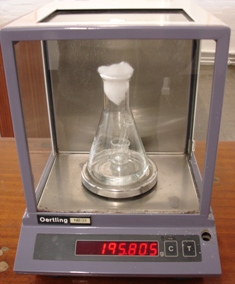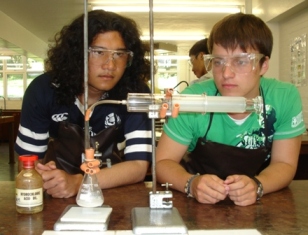Reaction rates
Introduction
 In the Applications and skills section of Topic 6.1 Collision theory & rates of reaction it states, " Investigation of rates of reaction experimentally and evaluation of the results", i.e. this forms part of the mandatory laboratory component. There are many different methods that could be used in a school laboratory to cover this area and also many simulations. This practical introduces two methods and as they are both measuring the amount of gas produced over time during the same reaction, one by mass and one by volume, the rates calculated by the two methods can be compared as they should be the same. This practical is written for the reaction of calcium carbonate with dilute hydrochloric acid. It could easily be adapted to study the reaction between magnesium metal and dilute hydrochloric acid instead but the mass difference will be much smaller due to the much lower molar mass of hydrogen compared to carbon dioxide. The two different methods are compared for three different concentrations of hydrochloric acid. To extend the practical slightly the mass loss method is then used to show the effect on the rate of increasing the surface area of the calcium carbonate and increasing the temperature of the reaction.
In the Applications and skills section of Topic 6.1 Collision theory & rates of reaction it states, " Investigation of rates of reaction experimentally and evaluation of the results", i.e. this forms part of the mandatory laboratory component. There are many different methods that could be used in a school laboratory to cover this area and also many simulations. This practical introduces two methods and as they are both measuring the amount of gas produced over time during the same reaction, one by mass and one by volume, the rates calculated by the two methods can be compared as they should be the same. This practical is written for the reaction of calcium carbonate with dilute hydrochloric acid. It could easily be adapted to study the reaction between magnesium metal and dilute hydrochloric acid instead but the mass difference will be much smaller due to the much lower molar mass of hydrogen compared to carbon dioxide. The two different methods are compared for three different concentrations of hydrochloric acid. To extend the practical slightly the mass loss method is then used to show the effect on the rate of increasing the surface area of the calcium carbonate and increasing the temperature of the reaction.
Teacher’s notes
To cover the evaluation of results this practical requires the plotting of graphs and taking a tangent to find the initial rate. In fact to compare the two methods students really need to convert both the mass of carbon dioxide released in one method and the volume of carbon dioxide released in the other method into molar amounts so there is a considerable amount of good processing to do. There is a lot of really good chemistry to tease out and the questions below can be given for students to aid their understanding. It will also act as part of the Scaffolding to train them and possibly help them when it comes to doing their internally assessed Individual Scientific Investigation.

The quantities used mean that the hydrochloric acid is always in excess and, if it all reacts, 0.500 g of calcium carbonate can produce a maximum of 0.220 g or 114 cm3 or of carbon dioxide measured at STP (273 K and 100 kPa). If possible, use a balance massing to ± 0.001 g for greater accuracy but one massing to ± 0.01 g will suffice.

 Student worksheet
Student worksheet
TO DETERMINE THE RATE OF A REACTION BY TWO DIFFERENT METHODS
INTRODUCTION
The rate of a chemical reaction can be followed by measuring the change in the concentration (or amount) of reactants used up over time or the change in the concentration (or amount) of products formed over time. This experiment explores two different ways of measuring the rate of reaction between limestone (calcium carbonate) and hydrochloric acid:
CaCO3(s) + 2HCl(aq) → CaCl2(aq) + CO2(g) + H2O(l)
Both methods measure the amount of carbon dioxide produced. The first method looks at the loss of mass of the reaction mixture as the carbon dioxide escapes from the flask. The second method measures the volume of carbon dioxide produced using a gas syringe. Both methods are compared for three different concentrations of hydrochloric acid. The loss of mass method is then used to observe the effect on the rate of changing the particle size (surface area) of the limestone and to observe the effect on the rate when the temperature of the hydrochloric acid solution is raised.
ENVIRONMENTAL CARE:
Because limestone is a natural material and the dilute acid reacts to form calcium chloride there are no particular environmental issues and the waste can be disposed of down the sink.
SAFETY:
There are no particular safety hazards except for the usual need for care when handling glassware and 1.0 mol dm-3 strength hydrochloric acid.
PROCEDURE:
1. Mass loss method. Weigh accurately about 0.5 g of limestone chips into a small test tube. Place 50.0 cm3 of 1.00 mol dm-3 hydrochloric acid solution into a conical flask and carefully stand the test-tube with the limestone inside upright in the flask on a balance. Record the temperature of the solution. Place a bung of cotton wool in the mouth of the conical flask. Record the total mass. Tip the test-tube over and thoroughly mix the limestone with the acid. Record the mass every fifteen seconds for three minutes. Take the temperature of the reaction mixture again after you have stopped recording the mass.
Repeat the experiment using 50.0 cm3 of 0.500 mol dm-3 hydrochloric acid and then again with 50.0 cm3 of 0.250 mol dm-3 hydrochloric acid.
2. Volume of gas method. Repeat the above experiment but connect a 100 cm3 gas syringe to the conical flask and record the volume of gas evolved every fifteen seconds (or until the volume reaches 100 cm3) once the test-tube containing the limestone has been tipped over and mixed with the three different concentrations of hydrochloric acid.
3. The effect of particle size. Repeat the mass loss method using 0.5 g of powdered limestone and 0.250 mol dm-3 hydrochloric acid solution.
4. The effect of temperature. Warm the 0.250 mol dm-3 hydrochloric acid solution to approximately 40 oC before adding 50.0 cm3 to the conical flask. Repeat the mass loss method using 0.5 g of limestone chips.
Record all your data in an appropriate way and compare the initial rate of the reaction for both methods when the concentration of the acid changes and for the mass loss method when the particle size and temperature change. Evaluate your experiment fully.
QUESTIONS:
1. Calculate the limiting reagent in each case and the maximum mass and volume of carbon dioxide that can be formed in each case with the three different concentrations of hydrochloric acid.
2. Plot graphs of loss in mass against time and volume of carbon dioxide against time for the three different concentrations of acid.
3. Take a suitable gradient in each case to estimate the initial rate of reaction.
4. Convert the units of the rate to mol s-1 in each case and compare the two values for each concentration of acid.
5. List some of the assumptions you have made in arriving at your rate values.
6. Explain why the temperature was recorded before and after the reaction.
7. What was the function of the bung of cotton wool placed in the conical flask in the mass loss method?
8. Explain why the rate increases when the surface area is increased and the temperature is raised.
This worksheet can also be downloaded from:

 IB Docs (2) Team
IB Docs (2) Team